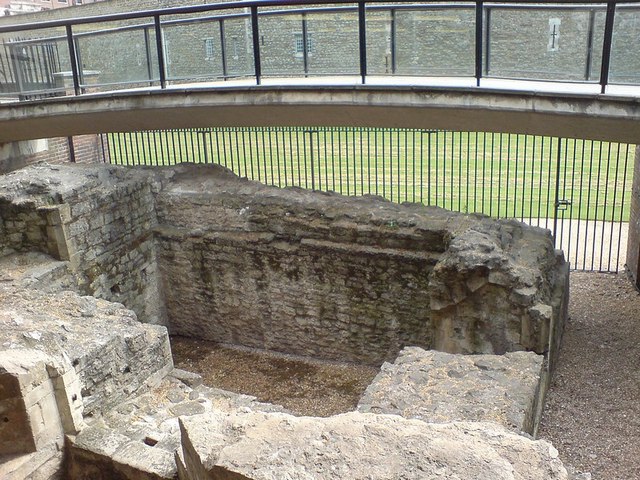Tower Hill Postern on:
[Wikipedia]
[Google]
[Amazon]
The Tower Hill Postern was a small fortified entrance (

postern
A postern is a secondary door or gate in a fortification such as a city wall or castle curtain wall. Posterns were often located in a concealed location which allowed the occupants to come and go inconspicuously. In the event of a siege, a postern ...
) at the eastern terminal point to the London Wall
The London Wall was a defensive wall first built by the Romans around the strategically important port town of Londinium in AD 200, and is now the name of a modern street in the City of London. It has origins as an initial mound wall and di ...
, at the junction of the Wall and the Tower of London
The Tower of London, officially His Majesty's Royal Palace and Fortress of the Tower of London, is a historic castle on the north bank of the River Thames in central London. It lies within the London Borough of Tower Hamlets, which is separa ...
moat. The size of the gateway indicates that it was suitable for pedestrians and horsemen but not wide enough to accommodate wagons, carts or carriages.


Antecedent gateway
There is no evidence for a gateway on the site earlier than the building erected byEdward I
Edward I (17/18 June 1239 – 7 July 1307), also known as Edward Longshanks and the Hammer of the Scots, was King of England and Lord of Ireland from 1272 to 1307. Concurrently, he ruled the duchies of Aquitaine and Gascony as a vassal o ...
around 1297-1308, and no reason for there to have been a gateway there before the expansion of the Tower of London. There are a number of circumstantial arguments including arguments based on road alignments, records of parochial disputes and indirect references by William Fitzstephen
William Fitzstephen (also William fitz Stephen), (died c. 1191) was a cleric and administrator in the service of Thomas Becket. In the 1170s he wrote a long biography of Thomas Becket – the ''Vita Sancti Thomae'' (Life of St. Thomas).
Fitzsteph ...
to indicate that there may have been a gateway further south that was replaced when much of the wall was demolished as part of the expansion of the Tower.
History
The Tower of London moat was dug in around 1270 as part of a scheme to extend the Tower, and part of the London Wall was demolished to make room for the expanded Tower and Moat. The postern at the edge of the moat, at the wall's new terminal point was probably built soon after, most likely in the period 1297-1308. The southern tower, which was built from Caen stone, partially collapsed in either 1431 or 1440, sliding vertically down three metres into the Tower Moat. The tower remained standing and though functionally impaired remained in use. There was a subsequent degree of re-building.Structure
The southern tower included a ground floor and a cellar, thought to have been reached by a ladder. The cellar had a window overlooking the moat. The remains of a stairwell and aportcullis
A portcullis (from Old French ''porte coleice'', "sliding gate") is a heavy vertically-closing gate typically found in medieval fortifications, consisting of a latticed grille made of wood, metal, or a combination of the two, which slides down gr ...
chase indicate that there was an upper floor and perhaps also a parapet on the roof. Nothing is known for certain about the tower north of the gateway except the information that can be gleaned from cartographic sources, all of which postdate the collapse of the southern tower. Some believe that the northern and surviving southern towers existed at the same time, while others think the northern tower was erected subsequently, to compensate for the loss of the southern tower.
Setting
The postern was situated in theLiberties of the Tower of London
The Liberties of the Tower, or the Tower Liberty is a small neighbourhood in the London Borough of Tower Hamlets, East London, which includes both Tower Hill and the Tower of London. The area was defined sometime after 1200 to provide an open are ...
, an area outside the jurisdiction of the City of London
The City of London is a city, ceremonial county and local government district that contains the historic centre and constitutes, alongside Canary Wharf, the primary central business district (CBD) of London. It constituted most of London fr ...
, which included the Tower itself and the surrounding areas. The area was under the control of the Tower in order that the defensibility of the Tower was not compromised by development leading up to the edge of the castle.Tower of London Local Setting Study, 2010, sec 4.1 The Tower Liberties are still outside the authority of the city, now being forming part of the London Borough of Tower Hamlets
The London Borough of Tower Hamlets is a London boroughs, London borough covering much of the traditional East End of London, East End. It was formed in 1965 from the merger of the former Metropolitan boroughs of the County of London, metropol ...
.
Remains
The foundations of the southern tower, which sunk into the moat, were excavated in 1979 and can be seen in the Tower Hill underpass.